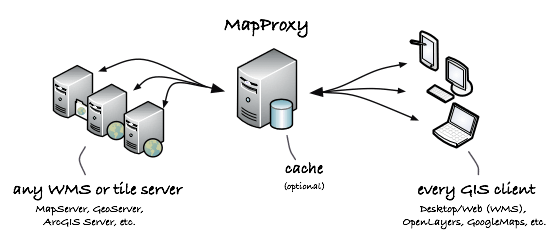This will build a docker image that runs mapproxy.
This recipe is adapted from the one provided by Tim Sutton https://github.com/kartoza/docker-mapproxy
Versions
Python 3.4Mapproxy 1.9.0

OpenLayers is a very popular Javascript API for web mapping. It’s deployed on the White House, used as the basis for a bunch of other projects. In a past life, I maintained one of those projects, the Drupal module and got a lot of experience using OpenLayers. MapBox launched Hosting with OpenLayers and kept it that way for quite a while before switching to Modest Maps. Mapping platform designed for quick publishing of zoomable maps online for web applications, mobile devices and 3D visualisations.
Getting the image
To build this image yourself you need toclone this repo locally first. Then build using a local url instead of directly fromgithub.
Then build using the command:
or simply:
To run the mapproxy container do:
This will create and mount a 'mapproxy' folder in your current working directory as a volumein the container. This is used to hold the config .yaml files. Mounting this volumeallows you to create the config files without having to rebuild the image.
The first time your run the container, mapproxy basic default configurationfiles will be written into ./mapproxy. You should read the mapproxy documentationon how to configure these files and create appropriate service definitions foryour WMS services. Then restart the container to activate your changes.
The cached wms tiles will be written to ./mapproxy/cache_data.
Note that the mapproxy containerised application will run as the user thatowns the /mapproxy folder.
The mapproxy container 'speaks' uwsgi so you need to put NGINX in front of it.This can be achived using Docker Compose, a tool for defining and running multi-containerDocker applications.A docker-compose file is included, which will start both the MapProxy container andand an NGINX container together, with the appropriate ports exposed and links betweenthe two containers.
Note docker-compose ships with the Docker Toolbox for Win/Mac users. Linux users willneed to install seperately.
The combination of APC and Memcache can really speed up sites based on these platforms. If you’re an admin of a server running Mac OS X Server (10.6), here’s how to install APC and memcache on Mac OS X server. Install Memcached on Mac OS. Memcached is a memory based caching mechanism and build using C language. To install memcached server on Mac OS or Linux we need C library. Here I am assuming that C library is already present in the system. If it’s not, then you can download C compiler and install it or install XCode that installs GCC compiler. Installing AMPPS locally on Mac OS X. The quickest way is to install Jamroom using the Softaculous installer (which comes with Ampps) by following the One Click Install Using Softaculous step below, but I do it manually (2 additional Manual Installation steps), and it still only takes a few minutes. If you like Jamroom please submit a. Installing memcache under MAMP is an absolute pain in the rear. Here's the easiest way I've found to do it. NOTE #1: I'm using Mac OS X 10.6.4 and MAMP Pro 1.8.3 for the install. The instructions will also work for newer versions, such as MAMP 1.9, but you'll need to change some paths, because MAMP 1.9 introduced PHP 5.2 and PHP 5.3 as options (rather than PHP 4.11 & PHP 5.2), and thus. Please teach install memcache apc on ampps for mac download. XAMPP on Mavericks install APC and Memcached. Ask Question Asked 5 years, 6 months ago. Active 5 years, 2 months ago. Viewed 2k times 1. What I already did. Install Apache, PHP and MySQL on Mac w/o MacPorts? Install Mavericks on new drive? How to install memcache on Mavericks?
To start the containers with Compose:
In your browser navigate to: